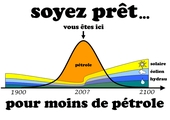Hello
I thought that this solution had potential, but in view of the weak points that you raise I think the other alternative and may be more adequate (always with the edf pulse contest).
I think of chemical storage by electrolysis
when there are peaks in electricity production
source:
http://pulse.edf.com/fr/reversible-elec ... e-chimique
and also in addition
[/ quote] Biofuel: cheap hydrogen produced from corn
Hydrogen as a source of clean, efficient energy ... and cheap: it could soon become a reality. A team at the Virginia Institute of Technology has developed a method for producing ecological and economical hydrogen from plant residues, in this case maize. A solution that could make it possible to generalize the use of this biofuel and fuel cell vehicles.
08 / 04 / 2015 at 15: 34 - By Nathalie Mayer, Futura-Sciences
18 comments Post a comment?
Researchers at the Virginia Institute of Technology use the most abundant sugars in plants in general and in corn in particular to produce hydrogen. They reduce the overall cost of producing hydrogen from biomass. © Tomas Moravec
Researchers at the Virginia Institute of Technology use the most abundant sugars in plants in general and in corn in particular to produce hydrogen. They reduce the overall cost of producing hydrogen from biomass. © Tomas Moravec
For the last ten years, Percival Zhang's team has been working on developing alternative and economical hydrogen production techniques. Researchers at the Virginia Institute of Technology (USA) are particularly interested in the actions of enzymes (the catalysts of cells) and their ability to release hydrogen retained in plants. In a recent issue of the Proceedings of the National Academy of Sciences, they unveil a low-cost, high-yield production method that exploits sugars in corn.
Why such an interest in hydrogen when its consumption is only a small percentage of global energy production? First, because with an energy density of 33 kWh per kilogram, it contains for example three times more energy than diesel and even 2,5 times more than natural gas. Moreover, used in a fuel cell, hydrogen, which combines with air to produce electricity, rejects nothing but water. It is therefore an ideal fuel for cars of the future. However, conventional generation technologies are still largely based on fossil fuels (hydrocarbons, natural gas, etc.). They are expensive and release large amounts of CO2. Hence the importance of the work carried out by Percival Zhang's team.
For Percival Zhang, hydrogen will play a major role in the future biofuels market. It could thus fuel the fuel cells of our vehicles. © P. Stroppa, CEA
For Percival Zhang, hydrogen will play a major role in the future biofuels market. It could thus fuel the fuel cells of our vehicles. © P. Stroppa, CEA
Extract hydrogen from corn glucose and xylose
There are already methods of producing hydrogen from biomass but they are usually based on a raw material of refined sugars, which already require an energy expenditure for their production. Researchers at the Virginia Institute of Technology are proposing to exploit biomass waste such as corn stalks or husks (the main grain grown in the United States). What would reduce costs and imagine a model of distributed energy production that would be both closer to the processing plants and consumers.
Based on a computer model, Percival Zhang's team peeled up the possible enzymatic reactions to degrade corn residue sugars with hydrogen and CO2 production. The researchers have discovered a series of reactions that do not exist in nature but are very effective in extracting the hydrogen contained in both corn glucose and xylose. By acting on these two types of sugars simultaneously, they have been able to increase the hydrogen release rate and to triple the volume produced more conventionally.
The Virginia Institute of Technology team has also been able to increase the efficiency of enzymatic reactions by a factor of ten over the best known methods today. A sufficient level to consider hydrogen production in small facilities, "similar to traditional gas stations," say the researchers. Especially since the biological reaction involved does not require the creation of special conditions that would require large technical means. The hydrogen produced can be easily separated from the enzymes in aqueous solution and remains of high quality. What widespread use of fuel cell vehicles, according to US researchers, and dramatically reduce the use of fossil fuels and greenhouse gas emissions.
The team already has the necessary funds to take the next step, that of the realization of an industrial demonstrator.
Source:
http://www.futura-sciences.com/magazine ... ais-57807/




